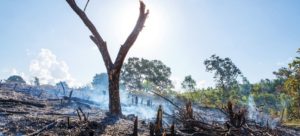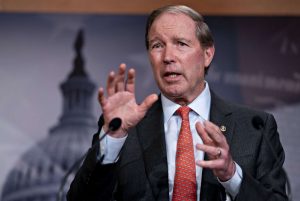The Canadian Cree artist Kent Monkman is celebrated for paintings that reflect the lives of Indigenous people, but some feel his new work goes too far.
TORONTO — Many Indigenous activists in Canada consider Justin Trudeau, after more than four years as prime minister, as little better than the other white colonial leaders who have oppressed them for the past 150 years.
His only Indigenous cabinet minister quit and his government approved pipelines across Indigenous territory, despite dissent and protests.
Despite that, even some of Mr. Trudeau’s sharpest critics were appalled by a painting by the celebrated Canadian Cree artist, Kent Monkman.
Titled “Hanky Panky,” Mr. Monkman’s painting depicts the prime minister on his hands and knees with his pants down as a crowd of Indigenous women looks on, laughing. Behind him is the artist’s alter ego, wearing knee-high stiletto boots and a long feather headdress.
ADVERTISEMENTContinue reading the main story
The image suggests themes of sexual violence and humiliation. And instead of cheers, the painting, released on social media this month, has inspired anger among many Indigenous people who say Mr. Monkman has gone too far.
Critics have described the painting as culturally degrading “revenge porn” that equates rape with retribution.
- Thanks for reading The Times.
The outcry was a sharp reminder that while Canada is under lockdown because of the coronavirus pandemic, the country’s existential crisis over the historic abuse of Indigenous people — and their continued overrepresentation in jails, foster homes, morgues, missing persons lists and poverty statistics — is still simmering.
“I don’t like the colonial government and don’t like things Justin Trudeau has said and done, but I would never wish sexual violence on anyone,” said jaye simpson, an Indigenous trans-woman and writer from Vancouver, who was among the piece’s vocal critics and whose name, by preference, is not rendered with capitals.

Mr. Monkman, who is Two Spirit, a broad term used by Indigenous people who identify as queer or gender nonconforming, has been recognized for representing Indigenous voices in his art. But “his work was never for us,” jaye simpson wrote on Twitter, referring to women and queer people from Indigenous communities. “It was never intended to keep us safe, nor empower us.”
In a statement posted on his website, Mr. Monkman said the feedback from his community would “have a lasting impact” on him and influence his work. He has also apologized, acknowledging that the elements he included to indicate consent in the painting were not prominent enough. (Mr. Monkman declined a request for an interview.)
Mr. Trudeau rose to power in 2015 with the promise to make “reconciliation” with the country’s First Nations, Metis and Inuit people central to his government. Since then, he has added another ministry to deal with Indigenous issues, proposed changing the citizenship oath to include a commitment to treaties with Indigenous people and worked toward providing clean water to First Nations reserves.
But his only Indigenous minister quit, saying she felt pressured in her job as attorney general to avert criminal charges for bribery against the powerhouse Canadian firm SNC-Lavalin, and his government approved pipelines across Indigenous territory. Many became disillusioned and cynical — a mood captured in Mr. Monkman’s painting.
“That’s what Monkman does: He takes an image and flings it in your face,” said Patty Krawec, an Ojibwe-Ukrainian podcaster in Niagara Falls, Ontario, who worked in a sexual assault center for years. “But in this one, he’s made us complicit in this violence. If this is retribution, how dare you make me complicit in that?”
Mr. Monkman is among the most successful artists in Canada. His work is coveted by the country’s elite and at international museums, including the Metropolitan Museum of Art in New York, which commissioned two large paintings by him and installed them in the museums’ entrance last November. Mr. Monkman’s recent large works have sold for more than $100,000.
Mostly, his pieces are historical paintings that subvert classical works by inserting Indigenous figures and stories. They often include his bawdy gender-bending alter ego, whom he has called “Miss Chief Eagle Testickle.”
Though he has said his paintings are meant to shock people and provoke questions, the visceral response to his latest piece surprised him.
“I wish for my work to resist the colonial traumas inflicted upon my own family and so many others for generations, not to perpetuate harm,” Mr. Monkman wrote on Facebook, offering an apology.

Mr. Monkman released his painting in frames on Instagram, building up the tension and surprise.
The text accompanying the final reveal stated the piece’s goal was to highlight “the problems with the Canadian (in)justice system.” It explained the pending act with the “grinning young man” at its center was consensual, indicated by the red handkerchief hanging from Mr. Trudeau’s rear pocket, a code “widely used in gay subcultures in the 70s and 80s.”
While Mr. Monkman had a relatively privileged upbringing in Winnipeg, with a Cree father and white mother, he has said he identified strongly with his paternal great-grandmother, who lived with them.
Get For You, a personalized daily digest with more stories like this.Sign up
His great-grandmother lost her daughter to a residential school, institutions mostly run by religious orders that were used by the Canadian government for more than a century as weapons of assimilation. Indigenous children were often forcibly removed from their families and cultures and placed in the schools, where many were physically and sexually abused.
One of Mr. Monkman’s best-known works is “The Scream,” featuring priests, nuns and Canadian policemen tearing children from the arms of screaming women.
Mr. Monkman runs his Toronto studio as Renaissance masters ran theirs. Apprentices work on his large pieces while he designs the concept and oversees the process.
Many of his paintings are assembled from multiple photo shoots of costumed models, whose images he changes in his final product. He has been criticized for using images of people in ways they may not approve.
“That’s the power imbalance,” said Lindsay Nixon, editor-at-large of Canadian Art magazine and a queer Indigenous art historian in Toronto.
“There’s this younger generation who are saying, ‘We feel so shocked and misrepresented by these images and this millionaire figure living in this very rich neighborhood of Toronto who is very disconnected from these communities that he purports to represent,’” she said.

If Mr. Monkman had previously been on the margins of the country’s cultural wars, his latest painting has tugged him into its center. The big question many are asking now is: Who is this art for?
“If he’s claiming to make traditional Cree art, then there’s a requirement to go back to the community,” explained David Garneau, a Metis artist, curator and professor of studio art and painting at the University of Regina. “If he is just an artist, there’s no need.”
He added, “Is he a moral agent, or is he an amoral artist?”
One of Mr. Monkman’s early buyers and boosters, Bruce Bailey, said he did not think Mr. Monkman should have apologized for this work.
“We cannot have censorship due to the sensitivity of the public,” said Mr. Bailey, who is white, and who said most of Mr. Monkman’s buyers were aging white gay men. “Once you give into the public mob, there is no more freedom of expression.”
Not all the reaction to the painting was negative, even within Canada’s various Indigenous communities. The Inuk throat singerTanya Tagaq wrote on Instagram that she thought Mr. Monkman’s work was “absolute genius.”
Murray Sinclair, a Canadian senator who led the country’s devastating Truth and Reconciliation Commission into the residential schools, described the work on Facebook as a“monumental testament to the treatment of Indigenous women and the public’s lack of caring. How? By reversing the roles of victim and victimizer.”
Mr. Trudeau’s office declined to comment on the piece. And for the moment, some Indigenous people in Canada have been willing to accept Mr. Monkman’s apology.
“We’ll see what happens with his next piece,” Ms. Krawec said.





